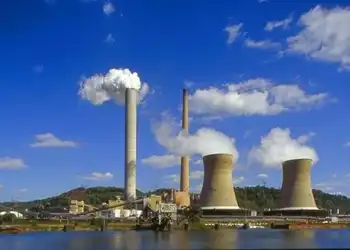TVA plant signals start of nuclear renaissance
The anticipated reopening of the Unit 1 reactor at Browns Ferry Nuclear Plant in Athens, Ala., about 110 miles south of Nashville, marks a revival of the country's nuclear energy program. The facility is to be reborn as a modern 1,200-megawatt atomic generator capable of lighting 650,000 homes.
Mothballed since 1985, the Browns Ferry reactor was the scene of a major fire sparked by a candle three decades ago.
No new nuclear plants have been built in the U.S. since the 1970s, but the Nuclear Regulatory Commission expects to receive fast-track construction and operating license applications for 28 reactors at 19 sites by 2009, most in the energy-hungry Southeast and Southwest.
"You could almost point to Browns Ferry Unit 1 as really the beginning of nuclear energy's rejuvenation in the United States," said Scott Peterson, vice president of the industry's Nuclear Energy Institute.
Growing demand for electricity and concern over global climate change are propelling this nuclear renaissance.
The Department of Energy estimates 50 new reactors will be needed by 2030 to keep pace. Tighter controls on greenhouse-gas emissions from coal-fired power plants are coming and will be expensive.
"If you care about global warming and clean air, it is hard not to be for nuclear power," said U.S. Sen. Lamar Alexander, R-Tenn., co-chairman of the TVA congressional caucus.
Dealing with the radioactive waste accumulating at plant sites — an industry volume that Peterson says would cover a football field 7 feet deep — remains a problem. There are political hurdles to overcome before burying it in Nevada. And technical roadblocks surround proposals to reprocess it like the French.
Among the utilities interested in bringing nuclear energy back is a group of power companies and equipment manufacturers called NuStart Energy Development LLC. The consortium, which includes TVA, is looking to build two reactors at TVA's unfinished Bellefonte plant site in Hollywood, Ala.
Knoxville-based TVA — the country's largest public utility, serving 8.7 million consumers in Tennessee and six surrounding states — also expects to decide by late summer if it will complete a second reactor at its Watts Bar plant in Spring City, Tenn. Watts Bar, the last new nuclear plant in the U.S., came online in 1996 after 22 years of construction. TVA still holds a construction license for a second reactor there.
TVA estimates it could finish the second unit by 2013 for around $2 billion, about a third of the cost of the first unit. That would give TVA three plants and seven reactors, with a two-reactor Bellefonte plant coming on board between 2018 and 2020.
"We are probably going to stay in the nuclear ballpark until the clean-air regulations clear up," TVA President and CEO Tom Kilgore told The Associated Press. "I think nuclear (projects are) going to be in our future for a decade."
TVA will have spent nearly $6 billion on emission controls for its fleet of 11 coal plants in Alabama, Tennessee and Kentucky under existing rules by the end of the decade. Tougher standards to capture carbon could cost billions more.
TVA's situation is not unique. Coal produces nearly one of every two megawatts of energy in this country, and about 40 percent of all carbon emissions. Carbon-free nuclear plants supply about 20 percent of the nation's electricity.
TVA gets 64 percent of its power from coal, 29 percent from nuclear, 6 percent from hydroelectric and 1 percent from natural gas and diesel. TVA's wind, solar and methane renewable energy program contributes less than 1 percent.
If Watts Bar 2 and Bellefonte are built, TVA's nuclear generation could approach 40 percent.
Jerry Paul, an energy policy expert at the Howard Baker Center for Public Policy at the University of Tennessee, said a "confluence of issues" is behind the nuclear rebound. "It is all about climate change and emissions. It is about economics and the recognition that nuclear power has the lowest operating cost for any form of baseload generation. It is about energy supply and security," said Paul, a lawyer, nuclear engineer and former senior Department of Energy official.
Nuclear plants cost about half as much to operate as coal-fired power plants but cost twice as much to build, Kilgore said.
Critics point to TVA's troubled nuclear history and worry if the self-supporting $9 billion government corporation is weighing all its energy options.
Kilgore said the agency is taking a conservative approach, building one plant at a time rather than several at once as it did in the 1970s, which contributed to TVA's scrapping much of a planned 17-reactor system when power supply quickly exceeded demand. He also said renewable energy and conservation programs can't satisfy a market growing nearly 2 percent annually.
"I think it is shortsighted. Rushing back to nuclear power is a real mistake," said Steve Smith, director of the Southern Alliance for Clean Energy.
While conceding a place for nuclear in TVA's generation mix, Smith cautioned that, "We are still digging ourselves out of the last experiment TVA did with nuclear power, and it led to the massive ($25 billion) debt that TVA continues to struggle with."
Related News

Electricity and water do mix: How electric ships are clearing the air on the B.C. coast
TORONTO - The river is running strong and currents are swirling as the 150-metre-long Seaspan Reliant slides gently into place against its steel loading ramp on the shores of B.C.'s silty Fraser River.
The crew hustles to tie up the ship, and then begins offloading dozens of transport trucks that have been brought over from Vancouver Island.
While it looks like many vessels working the B.C. coast, below decks, the ship is very different. The Reliant is a hybrid, partly powered by electricity, the seagoing equivalent of a Toyota Prius.
Down below decks, Sean Puchalski walks past a whirring internal…





